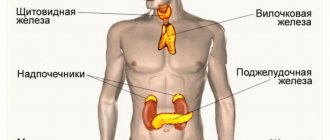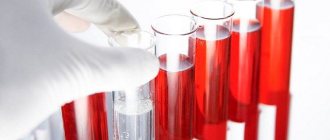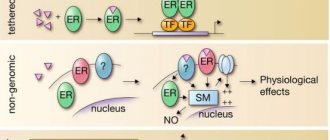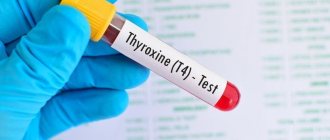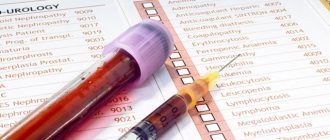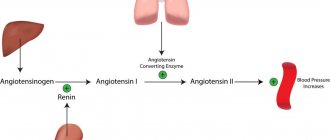Endocrine system - functions. How the endocrine system works
The content of the article
The job of the endocrine system is to control all physiological functions of the body. This complex network of glands located in different parts of the body is responsible for homeostasis - internal balance.
Endocrine system
Along with the nervous system and regulation at the tissue level, the endocrine system forms a highly specialized internal “processor” that controls all our vital parameters. When any part of the hormonal computer goes wrong, we immediately feel it.
What are the symptoms of hormonal disorders? Unpleasant sensations may arise from various organs; it also happens that other glands try to take over the functions of those that have stopped working properly.
Endocrine system. Norm and pathology
The endocrine system as a natural phenomenon
The endocrine system, also known as the system of neurohumoral regulation (literally “neuro-fluid control”), is extremely complex.
Its structure, composition and functioning are, apparently, at the limit of what modern science, armed with a powerful (as it seems to it) instrumental, laboratory-analytical and computational arsenal, can in principle explore and comprehend. An entire branch of medicine, called endocrinology, studies this system, its normal operation, its various dysfunctions and diseases, as well as methods for treating the latter. An entire sector of pharmacology is engaged in the development, synthesis and improvement of the so-called. hormone-containing drugs; Despite the chronic problem of side effects, it is no longer possible to do without this group of drugs today. Organs (glands), tissues or cells of a certain type related to the endocrine system, for example, Kulchitsky cells in the intestinal mucosa, produce special organic compounds, which are usually called bioactive regulators, neurotransmitters, signaling biochemicals, but most often simply hormones. This word translated from Greek means “to excite”, “to induce” or, in more modern parlance, “to activate”. Hormones enter directly into the bloodstream; the slightest fluctuations in their concentration in living tissues are captured by specific receptor cells that are sensitive to a particular group of hormones and capable of responding to hormonal “commands” - for example, an increase in body temperature, a decrease in blood pressure in the vessels, intense lactogenesis in the mammary glands, and many others etc. In this way, almost all physiological and mental processes in the body are launched, forced, inhibited or completely suppressed - in a word, controlled. Moreover, each gland secretes, as a rule, several hormones, and each hormone in turn affects several interrelated processes.
It is no coincidence that the synonymous term “neurohumoral regulation” contains the root “neuro-”. According to modern ideas, the endocrine system plays a very important, exclusive role in the life of the body, but still is not the “supreme power” in relation to it. Hierarchical dominance belongs to the central nervous system (CNS), i.e. brain and spinal cord. Hormones are responsible for everything, but the secretory activity of the endocrine glands themselves is controlled by special cerebral formations and appendages, primarily the hypothalamic-pituitary ligament in the lower region of the brain, the so-called. diencephalon - using signal electrochemical impulses and a whole web of neural communication channels (in IT, such an internal network would be called an intranet). Given the above, endocrinology today is increasingly identified with neuroendocrinology (which half a century ago was considered a separate field), and a group of disorders previously traditionally called hormonal are interpreted as neuroendocrine diseases or dysfunctions.
It is difficult to say why such a complex, multi-stage and multi-element neuroendocrine system arose in evolving mammals. As you know, nature cares most about expediency, and least of all about making it convenient for humans to study it. Nature always has a lot of possible paths and options; most likely infinitely many. It would certainly be possible to regulate the life activity of higher organisms in some other way, and preferably in a simpler way. However, the following cannot be denied. Modern, intelligent and technological man is still very far from creating an artificial system similar to himself - a system that is equally compact, energy-saving and efficient, possessing five autonomous sensor units and two universal manipulators; a system that optimally combines strength, flexibility and mobility, unconditioned and conditioned reflexes, consciousness and the unconscious; in addition, a self-reproducing system, to some extent self-learning and, most importantly, maintaining homeostasis (constancy of internal conditions), i.e. self-adjusting to almost any external conditions. Therefore, today we can only admire, thank nature for our amazing endocrine system - and continue the persistent study of its countless mysteries.
Pituitary gland - pituitary hormones (prolactin, endorphins, ACTH hormone and TSH hormone
The pituitary gland stimulates the growth of long bones and body growth, regulates metabolism, is responsible for the secretion and maintenance of milk in nursing mothers, stimulates the breakdown of excess fat, and also influences the development and function of the testes or ovaries. The pituitary hormones it produces include prolactin, endorphins, ACTH hormone and TSH hormone.
Pituitary hormones
Thyroid gland - thyroid hormones (thyroxine, triiodothyronine, calcitonin)
Thyroid hormones affect the functioning of the entire body, and the most important of them are: triiodothyronine (FT3), free thyroxine (FT4), calcitonin.
The thyroid gland is regulated by thyrotropin (TSH), produced by the pituitary gland, as well as hyperthyroidism and hypothyroidism, including Hashimoto's disease, one of the most common hormonal disorders today.
Pancreas - pancreatic hormones - glucagon, insulin
The most important hormones of the pancreas are glucagon, which stimulates blood glucose levels to rise, and insulin, which lowers blood sugar levels.
Biological role of glucagon
In a healthy person, insulin works with glucagon to maintain the required level of energy in the body. The most well-known disease of the pancreas is diabetes, caused by impaired insulin secretion or tissue sensitivity to the hormone. The most common types of diabetes are type 1 diabetes and type 2 diabetes.
Symptoms and diagnosis of endocrine diseases
Endocrine disorders are numerous, and their development and symptomatic picture are often unpredictable. The system for regulating the activity of internal organs performs an important function, ensuring the production of special substances - hormones. Often a malfunction occurs in the operation of this system, leading to the development of pathologies and diseases.
An endocrinologist is involved in identifying the causes and diagnosing diseases. After consultation and examination of the body, the doctor determines how the disease progresses and what treatment methods are relevant for a particular patient.
Qualified doctors from Novocherkassk and the Rostov region receive consultations at the Women's Health Center "Femina". Make an appointment by calling 8 8635 29 15 16.
List of major endocrine disorders
The function of hormones is of great importance for the physical, mental and physiological state of a person. Failure in the functioning of endocrine organs leads to the development of pathological processes that are accompanied by changes in the hormonal system:
- disruption of production - decrease or increase;
- slower transport and absorption;
- abnormal structure;
- resistance against hormonal action increases.
Such processes affect all internal human organs, including the nervous system, leading to the development of various diseases.
Major endocrine system disorders:
| Disease | Reasons for development | Symptoms |
| Hypothyroidism | Production of low levels of hormones, leading to hypofunction of the thyroid gland | Decreased metabolic processes, slow heart rate, constipation, menstrual irregularities. The primary stage occurs with severe fatigue. Women are most susceptible to the disease - the disease is diagnosed 18 times more often than in men. |
| Diabetes | Complete or partial lack of insulin in the body, leading to metabolic dysfunction | Constant feeling of thirst, increased appetite, frequent urination, changes in the skin. |
| Goiter | Hypo- or hyperfunction of the thyroid gland occurs due to insufficient iodine intake | Accompanied by an enlarged thyroid gland. |
| Thyrotoxicosis | Increase in T3 and T4 hormones in the blood | A sharp decrease in body weight, acceleration or failure of the heart rate, increased sweating, irritability, nervousness |
| Autoimmune thyroiditis | Inflammation of the thyroid tissue, developing against the background of decreased immunity | Depression, excessive fatigue, dry skin, brittle nails, menstrual irregularities, decreased libido, weight gain of 10 kg or more. |
| Hypoparathyroidism | Insufficient production of PTH, parathyrin and parathyroid hormone, which affect metabolism. Often the disease develops after surgery. | Seizures, numbness and chills of the extremities, hot flashes, sensation of muscle spasms. |
| Hyperparathyroidism | Increased secretion of parathyroid hormone, accompanied by impaired metabolism of microelements | Emotional imbalance, “duck” gait, fatigue during normal physical activity, earthy-gray skin color. |
| Gigantism | Chronic excess of somatotropic hormone (GH). Typically transmitted genetically | Diagnosed only in adults. Accompanied by disproportionate growth of bone, cartilage, soft tissues, as well as internal organs. |
Signs and methods for diagnosing endocrine diseases
The endocrine system consists of different endocrine glands; diseases also have a wide range of clinical manifestations. People often attribute the first signs of these diseases to fatigue after work or physical labor, stress, or overeating. In this case, the disease progresses, and damage to the endocrine gland becomes chronic.
General signs of endocrine diseases:
- increased fatigue during normal physical activity;
- weakness, muscle spasms;
- sudden weight loss or gain;
- fast or slow heartbeat, pain;
- feverish condition;
- increased sweating;
- excessive, unnatural excitability or, conversely, drowsiness;
- frequent urge to urinate is an indirect symptom, each patient has his own norm;
- constant thirst;
- high blood pressure with headaches;
- decreased memory function;
- regular occurrence of constipation or diarrhea.
In case of such a clinical picture, it is necessary to contact an endocrinologist. The following additional examination methods are used:
- MRI;
- CT;
- radiography of the skull;
- Ultrasound.
Laboratory research:
- blood test for sugar levels;
- blood biochemistry;
- glycosylated hemoglobin;
- glucose test;
- blood and urine test for hormones.
A detailed examination of the body will make it possible to diagnose the disease at the first stage, leveling out the pathology. You can make an appointment with an endocrinologist in Novocherkassk online on the Femina MC website.
Manifestation and diagnosis of endocrine diseases in ophthalmopathy
Signs of endocrine disorders in ophthalmopathy are caused by the presence of pathology in the thyroid gland. This leads to an expansion of the list of characteristic manifestations:
- upward lifting of the eyelid, swelling;
- feeling of pressure and pain on the eyeball;
- dryness of the mucous membrane of the eye;
- failure to perceive colors;
- exophthalmos;
- conjunctivitis;
- limited movement of the eyeballs;
- rare blinking;
- trembling and pigmentation of the eyelids.
Most cases do not lead to complete loss of vision function, but can cause vision loss, corneal damage, double image, and neuropathy.
If the clinical picture of the disease is pronounced, then a standard examination by an ophthalmologist is sufficient. The study included analysis of color vision and eye movement, optical media and perimetry. In unclear cases, ultrasound, MRI and CT are required.
Male hormones
The male gonads, located in the scrotum, perform two main functions - reproductive (sperm production) and hormonal, as the site of production of male sex hormones. Their work is regulated by hormones produced by the pituitary gland.
Male androgens are steroid hormones, of which testosterone plays the most important role. Its activities include sex formation and the development of secondary sexual characteristics, stimulating the development and maturation of sperm, and regulating sexual desire.
Interpretation of analyzes
Thyroid hormones
Triiodothyronine , or T3, gives a general assessment of the functioning of the thyroid gland. This hormone is determined both in free form (normal: from 2.6 to 5.7 pmol/l.) and in the serum state (general form; normal: from 1.3 to 2.7 nmol/l). An increase in the indicator indicates the use of narcotic substances: methadone, heroin, amphetamine, HIV infection, renal failure, hyperthyroidism. A decrease was established with the use of androgens, danazol, dexamethasone, and propranolol.
Thyroxine , or T4, regulates energy metabolism in the body. Normal: 10.8 - 22.0 pmol/l. Low levels are observed in hyperthyroidism and hemolysis. Increased levels – when taking oral contraceptives, methodone, heroin, estrogens.
Thyroglobulin , or Tg, is prescribed for suspected malignant neoplasms. Normal: <55 ng/ml.
Antibodies to thyroglobulin - prescribed for suspected autoimmune diseases of the thyroid gland. Normal: 0 - 18 U/ml.
Microsomal antibodies are the most accurate indicator of the presence of autoimmune diseases. Deviation from the norm <5.6 U/ml is evidence of aggression of the immune system towards its own body.
Thyroxine-binding globulin , or TSG, is responsible for transporting the hormones T3 and T4. Normal: from 16.8 to 22.5 mcg/ml. An increased indicator may indicate pregnancy, a decreased indicator may indicate cirrhosis of the liver.
Adrenal hormones
Cortisol – regulates carbohydrate metabolism. Norm: from 230 to 750 nm/l. A low indicator may be the result of chronic adrenal insufficiency, and a high indicator may indicate oncology or adenoma.
Aldosterone is responsible for water-salt balance. Norms: in a horizontal position 17.6-230.2 pg/ml; in a vertical position 25.2-392 pg/ml. Elevated levels of the hormone in the blood usually indicate an adrenal tumor.
Norepinephrine and adrenaline - normalize heart rate, blood pressure, and form glucose levels. Norms: from 1.92 to 2.46 nm/l for adrenaline, from 0.62 to 3.23 nm/l for norepinephrine. An increase in indicators indicates kidney disease, Itsenko-Cushing syndrome, emotional and physical stress in the body, a decrease indicates pathologies of the hypothalamus.
Sex hormones
Estradiol is responsible for the production of germ cells and the proper development of pregnancy. The norm in the first phase of the menstrual cycle (follicular phase) is from 200 to 285 pm/l, the norm in the corpus luteum phase (luteal phase) is from 440 to 575 pi/l, during menopause from 50 to 133 pm/l. A reduced indicator may indicate a tumor in the ovaries, an increased indicator may indicate their insufficient functioning.
Testosterone is the main male hormone. Responsible for the formation of secondary sexual characteristics, stimulates the growth of muscle mass and bones. Norms: for men – 2 -10 ng/ml, for women – 0.2 – 1 ng/l.
Progesterone – ensures the proper development of the genital organs in women. The norm in the first phase of the menstrual cycle (follicular phase) is from 1 to 2.2 nm/l, the norm in the corpus luteum phase (luteal phase) is from 23 to 30 nm/l, during menopause from 1 to 1.8 nm/l . An increase in the indicator is observed with tumors of the adrenal cortex, a decrease is observed with ovarian sclerosis.
Hormonal disorders
All alarming symptoms that may indicate dysfunction of one or more endocrine glands should be reported to an endocrinologist. In any case, only this doctor treats such disorders, and when contacting another specialist, he will still redirect the patient to a hormonal specialist - an endocrinologist.
ONLINE REGISTRATION at the DIANA clinic
You can sign up by calling the toll-free phone number 8-800-707-15-60 or filling out the contact form. In this case, we will contact you ourselves.
Thyroid
The thyroid gland is a small endocrine gland located on the front surface of the neck and consisting of two halves connected by an isthmus. It produces the same thyroid hormones that have a close relationship with TSH.
Thyroid hormones are biologically active substances whose molecules contain iodine. These are thyroxine (T4) and triiodothyronine (T3), which regulate the processes of growth and development of the body, and are also involved in the regulation of metabolic rate. They increase the tissue's need for oxygen, and also contribute to an increase in blood pressure, frequency and strength of heart contractions.
A person’s energy, psychological energy and the speed of cognitive processes depend on thyroid hormones. They also promote the formation of glucose in the liver and its use by cells, while they suppress the accumulation of glycogen. In addition, thyroid hormones promote faster decomposition of fat and prevent the formation of new ones.

